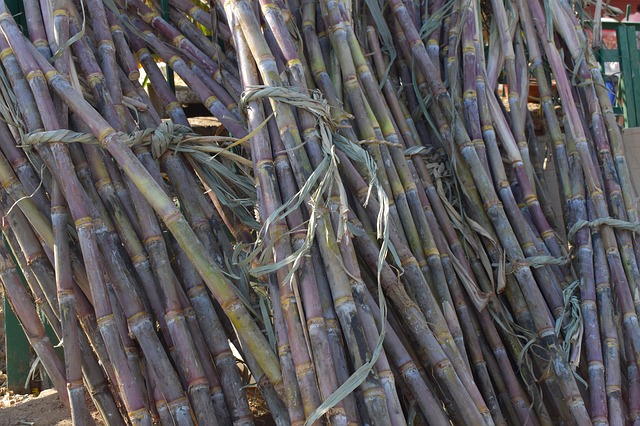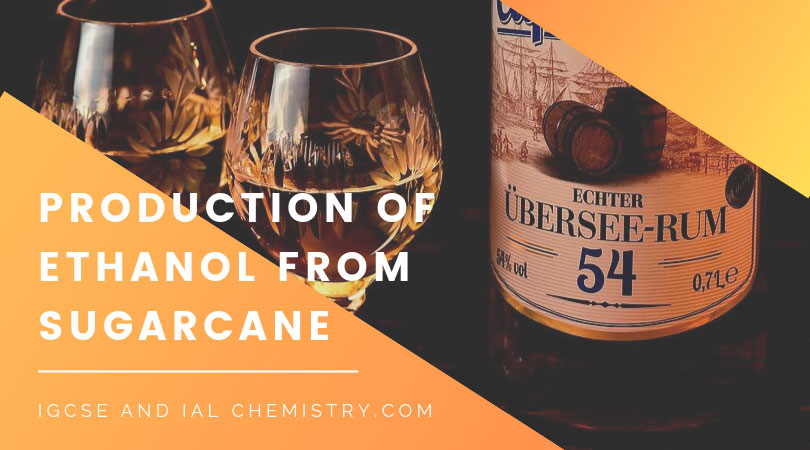Ethanol is one of the most important chemicals in the chemical industry, it is used in many important reactions, it is used as bio-fuel, and most importantly it is a key ingredient of alcoholic beverages such as wine, beer, rum, etc. Ethanol is mainly produced in two ways, Fermentation and Hydration. In this blog, I am mainly going to discuss the Fermentation process in detail, but also make sure that I am staying within the confines of the IGCSE Organic Chemistry syllabus. So let’s get started!
Ethanol is alcohol if your concepts with the structure of alcohol are not clear. Then have a look at my “Alcohol Organic Chemistry Notes“. This will help you understand things a little bit better.
In case you are a complete beginner in organic chemistry, I would also recommend you to read this awesome book “Organic Chemistry I For Dummies (For Dummies (Lifestyle))“ from Amazon.
Why Sugarcane is used to make Ethanol
I am assuming that you are not familiar with Sugarcane, it is the plant from which sugar is made. Even though it is a very common type of plant. But you might be living in a different region, so here is some information about sugarcane from Wikipedia below.

Sugarcane, or sugar cane, or simply cane, are several species of tall perennial true grasses of the genus Saccharum, tribe Andropogoneae, native to the warm temperate to tropical regions of South Asia, Southeast Asia, and New Guinea, and used for sugar production. (collected from Wikipedia)
The main ingredient of sugarcane which is used to produce ethanol is glucose. In the fermentation process, the glucose from sugarcane is converted to ethanol. The formula of glucose is C6H12O6, it is a complex molecule that is made of 6 carbon atoms, 12 hydrogen atoms, and 6 oxygen atoms. For the IGCSE Chemistry syllabus, we do not need to be concerned about the structure of glucose. We are only concerned about the equations, conditions, and the products which are formed.
Different Steps in Fermentation
STEP 1: Dissolving Sugarcane Juice in Water
Firstly, the juice from the sugarcane is obtained and filtered to remove any kind of dirt or debris. The glucose is not directly in the sugarcane juice. The sugarcane juice consists of sucrose (C6H12O6). The juice is dissolved in water, when dissolved the sucrose breaks down to form glucose and fructose.
C12H22O11(aq){Sucrose} + H2O)(l) → C6H12O6(aq){Glucose} + C6H12O6(aq){Fructose}
Glucose and Fructose have the same molecular formula but different structural formulas. This means that they have the same number of carbon, hydrogen, and oxygen atoms, but are arranged in a different manner in each. It is only the glucose that is converted to ethanol in the fermentation process, the fructose is left out.
STEP 2: Yeast is added
What is yeast? Yeast is a kind of micro-organism, it kind of looks like a white powder. The mixture of glucose and fructose is put in a closed container with Yeast in the absence of oxygen. In the absence of oxygen, the yeast respires anaerobically. To learn more about anaerobic respiration. Have a quick look at this blog.
STEP 3: Yeast converts glucose to ethanol
When the yeast respires anaerobically, it produces an enzyme called zymase which converts the glucose to ethanol. So it is zymase that converts the glucose to ethanol and not yeast itself.
C6H12O6(aq){Glucose} → 2C2H5OH(aq){Ethanol} + 2CO2(g){Carbon dioxide}
During the fermentation process glucose is converted to form Ethanol and carbon dioxide. Here the carbon dioxide is the byproduct that is simply released into the atmosphere. During the fermentation process, you might see a little bit of bubbling which is caused by the formation of carbon dioxide gas.
The ideal temperature for this process is between 30°C to 40°C. If the temperature is too low the yeast wouldn’t respire fast enough or may even stop. If the temperature is too high, the yeast will die.
The yeast is killed if the alcohol content in the mixture rises more than 15%. So it is impossible to produce highly pure ethanol with the fermentation process. So the end product is mainly a mixture of ethanol, water, yeast, and mixed carbon dioxide. Different types of alcoholic drinks have different amounts of alcohol contents, so the fermentation is done until the alcohol content approximately reaches that amount. For example, the alcohol content of beer is 4.5%, wine is 11.6%, vodka is 40%, and so on.
STEP 4: Purification
As I mentioned in the previous step, the ethanol which is produced is very impure. The final mixture contains solid yeast, lots of water, and dissolved carbon dioxide it. So here are the steps below which is used to purify the ethanol even more.
FILTRATION: The mixture is firstly filtered to remove the solid yeast from the total mixture.
FRACTIONAL DISTILLATION: after the mixture is filtered, there is still a lot of water dissolved in the mixture. So to collect the pure ethanol from the mixture of water and ethanol, the fractional distillation process is followed. This process is mainly based on the fact that water and ethanol have different boiling points. Ethanol has a boiling point of 78°C and water has a boiling point of 100°C. So when the mixture is heated, the ethanol boils off at 78°C and gets collected in a separate container. To learn more about the fractional distillation process you can have a look at my blog “Separating and Analysis“. During this process, the mixed carbon dioxide is also removed from ethanol.
Uses of Ethanol
There are many uses of ethanol, but the ethanol which is produced by the fermentation process is not so pure. The ethanol which is produced by fermentation is mainly used to make alcoholic beverages such as wine, beer, vodka, rum, etc. It is also used as biofuel.
Conclsion
So in this blog, I have covered from scratch how ethanol is produced from sugarcane, the conditions required for fermentation, and the different types of products formed. I have also discussed of how the ethanol is purified.
I hope that you have found this blog useful, please feel free to bookmark this blog for later use. Also please share this blog with your friend who might need help in this topic.

